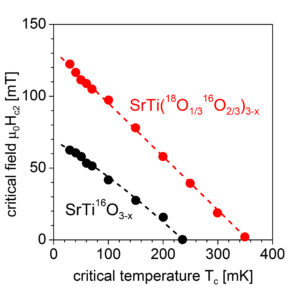
Strontium titanate is a material with a unique combination of different properties. In its pristine state it is an insulator with a band gap of 3 eV. In the absence of zero-point fluctuations (ZPF) the material would be ferroelectric at low temperatures, and the material can be made ferroelectric by suppressing the ZPF by substituting more than 30 percent of the natural oxygen by the heavier 18O. When doped with a small density of electrons between 1016 and 1021 per cubic centimetre, the material becomes conducting, with a high mobility and a resistivity varying as T2. Below typically half a Kelvin it becomes superconducting; the question as to why this happens is still open. SrTiO3 is a conventional insulator (unlike the high Tc cuprates, which are doped Mott-insulators) and it is almost certain that the superconductivity has to do with electron-phonon coupling. However, the way in which this happens is subject of on-going research.
Adrien Stucky et al. measured the effect of 18O substitution on the superconductivity and observed a striking rise of the superconducting transition by a factor 1.5 as well as a doubling of the upper critical magnetic field. The sign the observed effects is opposite to that in a conventional superconductor such as Pb and the influence on Tc is an order of magnitude much stronger. This points toward an unconventional pairing mechanism, which could be the consequence of polaronic band-narrowing, coupling to ferroelectric fluctuations, or a combination of those.
This research has been published in Scientific Reports.
Contacts: Prof. Dirk van der Marel, Dr Enrico Giannini, Adrien Stucky